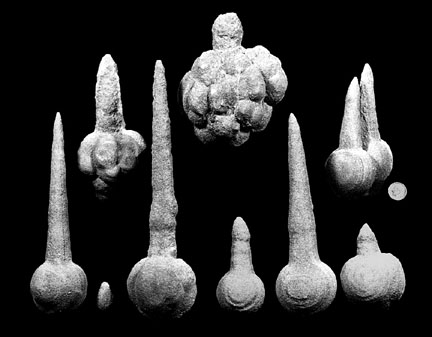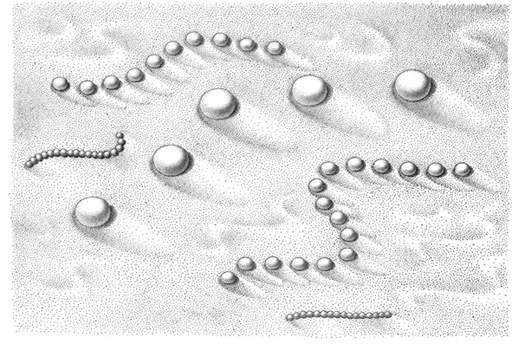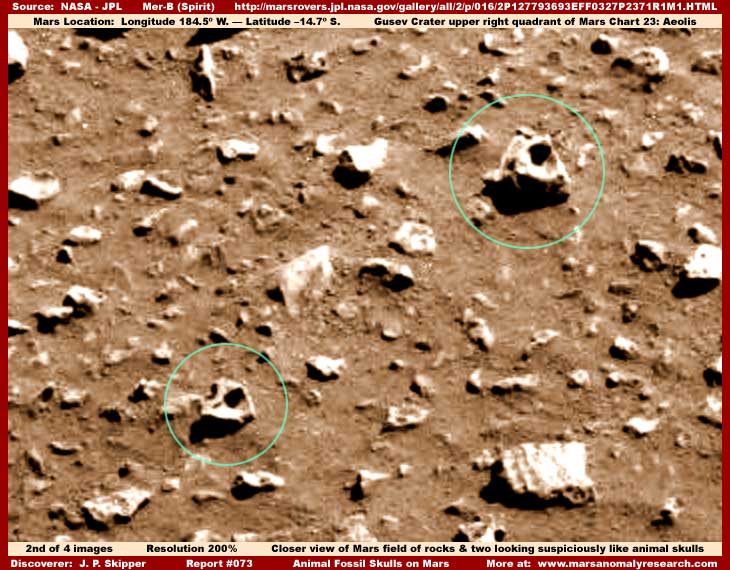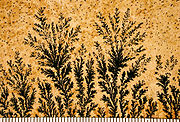Our neighbouring planet Mars is often the source of speculation and fantasy when it comes to discovering alien life. It conjures up images such as those in H.G. Wells epic War of the Worlds, the sort of aliens which of course are out of the question, but is life on Mars a complete fantasy? Mars lost most of its atmosphere due to its small size, making it incapable of sustaining a liquid core and before long the planet became dead and stripped of its atmosphere by solar radiation. Although life could not be supported any more, it may have existed in the past.
Recently (see here) scientists have identified rocks on Mars which may contain the traces of past life. The rocks in a region known as Nili Fossae are said to bear resemblance to rocks in Australia in which the earliest traces of life on Earth have been found. The rocks are up to 4 Ga old and contain carbonate, the mineral portion of organisms which often fossilises on Earth. What they hope to one day find on Mars are stromatolites, microbial structures like those found in Precambrian rocks and onwards (see here for some Permian stromatolites I live near). Mineralogically the rocks on Mars are very similar to the rocks in which ancient stromatolites are found in Australia.
An Australian Precambrian stromatolite
In 2011 NASA will be launching a new rover to Mars, for which Nili Fossae was originally put forward as a potential landing site (it has been narrowed down to four sites) but it has been considered too dangerous as the surface is uneven. Sadly this means not finding out whether the rocks do contain fossils any time soon, but the chance may come again in 2018. If they do eventually find putative fossils, establishing what they are will take a lot of time and debate. They may be fossils, but may also be geological structures.
Meteorite Fossils?
Claims of life from Mars have been made in the past. The well known ALH 84001 meteorite from Alan Hills contained structures which appeared to be bacteria to some scientists in 1996 (see image to the left). Organic molecules were also found on the meteorite, though it is not yet established whether they are exobiologic in origin or contaminants. The evidence has not been discredited, but it is not considered to be strong enough evidence for the claims made.
Martian Fossils?
Do a quick Google search for something along the lines of "Mars fossils" and you will likely find this interesting site titled Mars Fossils, Pseudofossils or Problematica? It discusses images from Mars missions and the possibility that they provide evidence for Martian fossils. The ones labelled "spherules" are rather interesting, but highly unlikely to be biological in origin. As seen below, they resemble botryoidal haematite though they appear to have some sort of stalk, leading some to think they may have a genuine stem or roots:
The likely explanation for these is that the minerals formed in an uneven channel, with gaps allowing the mineral to take on its characteristic ball shape. Later erosion would reveal these mineral balls along with the mineral channel which they formed from. Some of the images show these spherules with dimples where the stalk may have broken off.
On the right are concretions found on this planet which were not likely produced by organisms and are possibly the result of the same processes which the Martian spherules resulted from.
An interesting fossil parallel has been drawn between the Martian spherules and Horodyskia which may have been multicellular or colonial. Horodyskia is dated to between 1.5 and 0.9 Ga ago. It is an interesting comparison, but an unlikely one.
There are even claims of fossil algae, see the image to the right for example:
There are also purported "exo-cephalopods" and worms, though looking at the images I had no idea how they saw such things.
Without any other evidential backing these claims are extremely wild and most likely to be a case of people seeing what they want to see and more. Keep searching on the internet and you will find more amusing images which don't amount to spherules and algae. For example, the image below shows weathered rocks which people have seen and compared to animal skulls:
Crazy huh? But there is a serious point to be made here. When looking at fossils on Earth we can often have trouble trying to establish that they were originally life forms as pseudofossils are readily found throughout the geological record. Further to this, once it has been established that life is the cause of the features we then have the issue of identifying them, with many fossils being labelled problematica. Many problematic fossils are found the further back we look, mostly in the Precambrian, so Martian fossils, which would be even older, would be incredibly difficult to identify.
Pseudofossils
Identifying terrestrial fossils can be tricky as many non-biological processes can produce things which look like fossils. One of the more common and beautiful pseudofossils are manganese dendrites which have an appearance like the silhouette of trees, formed when manganese precipitated into the rock. In my recent trip to Runswick Bay I spotted some slabs in a driveway with dendrites on them, making for quite pretty paving.
Some pseudofossils look like organic remains and can easily fool people who are looking for fossils. Flint nodules, such as the ones below, can often appear to resemble things like body parts.
Pseudofossils will likely be found on Mars, so any claims of fossils will have to be heavily scrutinised. Many fossils which are accepted as of biogenic origin were first seen as pseudofossils. When the Ediacaran fossils of Australia were first found, Reg Sprigg recognised them as organic, however, they were dismissed by others as products of weathering. Dickinsonia (below) was dismissed at first, though is now one of many Ediacaran problematica.
Sprigg's original views turned out to be correct and now it is well established that fossils occur in the Precambrian. An interesting Ediacaran form which has constantly changed in interpretation is Vermiforma antiqua, an unusual structure which has clearly been difficult to interpret.When originally found they were labelled as body fossils, belonging to the oldest animals known in the US, possibly related to worms. One explanation given was that it was produced by sand volcanoes, making it a pseudofossil which looks like a trace fossil. It was, for quite some time, labelled as an ichnofossil, a trace fossil, in this case made by a frond-like Ediacaran secreting mucus. Another pseudofossil explanation, one which seems to be current consensus, is that the features are tectographs, tectonic artefacts and not biologic traces.
Not all fossils (and pseudofossils) are as difficult to establish as Vermiforma, though once they are identified as fossils comes the difficulty of working out what they are. Martian fossils would be difficult to interpret, though it is unlikely that they got beyond microbes. Establishing whether we have fossil bacteria can be difficult as they rampantly contaminate rocks and can fossilise on occasion. Stromatolitic structures would be the best evidence for life on Mars, but the ability to discover such structures may be waiting for us in the future.
Conclusion
Until we can properly investigate these rocks, it is unlikely that we will be able to demonstrate that there was life on Mars. It may even have to wait until we are able to transport people to the red planet's surface. Until then we will likely see more and more images where people see what they want to see. I don't rule out the possibility of microbes on Mars and it is not completely out of the question that the Martian Seed hypothesis for the origin of life is accurate, but if it is found I don't expect it to be anything more than prokaryotic life and difficult to demonstrate unless they have formed microbial mats and microfilms. It is also plausible that life was once there but left no discernible traces as it happened so long ago and the life was so small and short-lived. It is a question which may never be answered, but either way will be on our minds for a long time.
Last Note - Waters of Mars
In a Doctor Who special titled Waters of Mars, a base, in the future, was set up on Mars and research was taking place there. Of course, something fantastical went wrong, but some aspects were not too out of the question. The idea of a Mars base is a future possibility and among the crew was a geologist. In this case the geologist, Mia Bennett, was played by Gemma Chan, who would be ample enough reason for me to volunteer to be a Martian palaeontologist even though I think it highly unlikely. Below is the crew of the Martian base.
And this is Gemma Chan, who coincidentally was on TV as I wrote this, in an episode of Sherlock:
So, where do I sign up to leave behind the world of Earth-bound palaeontology in favour of the rusty red planet?













No comments:
Post a Comment